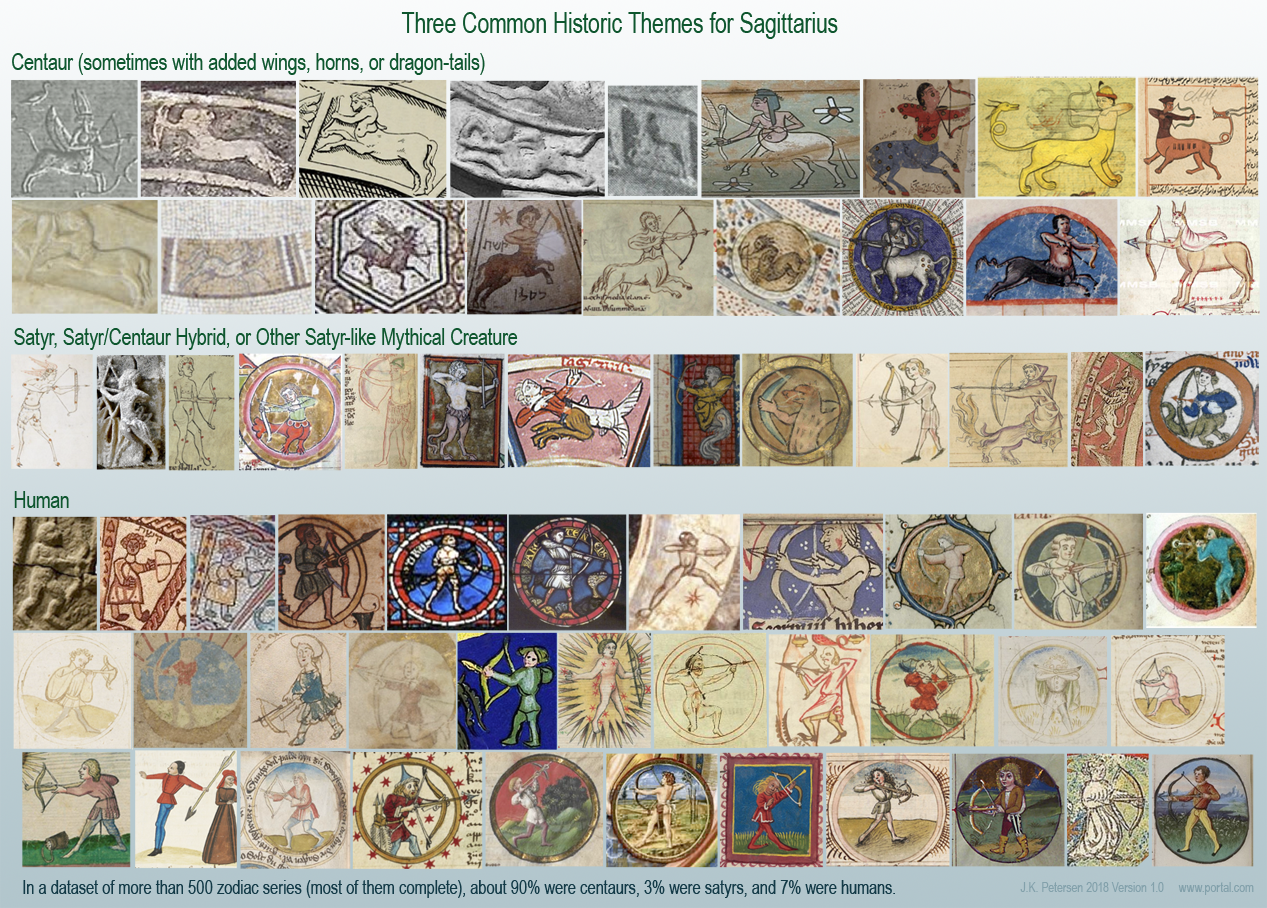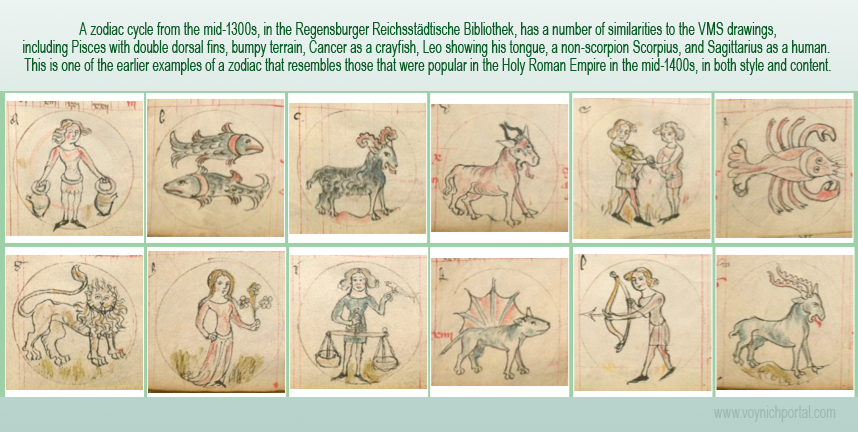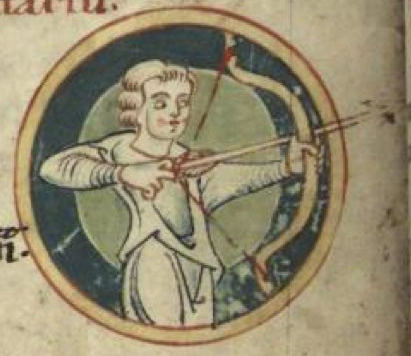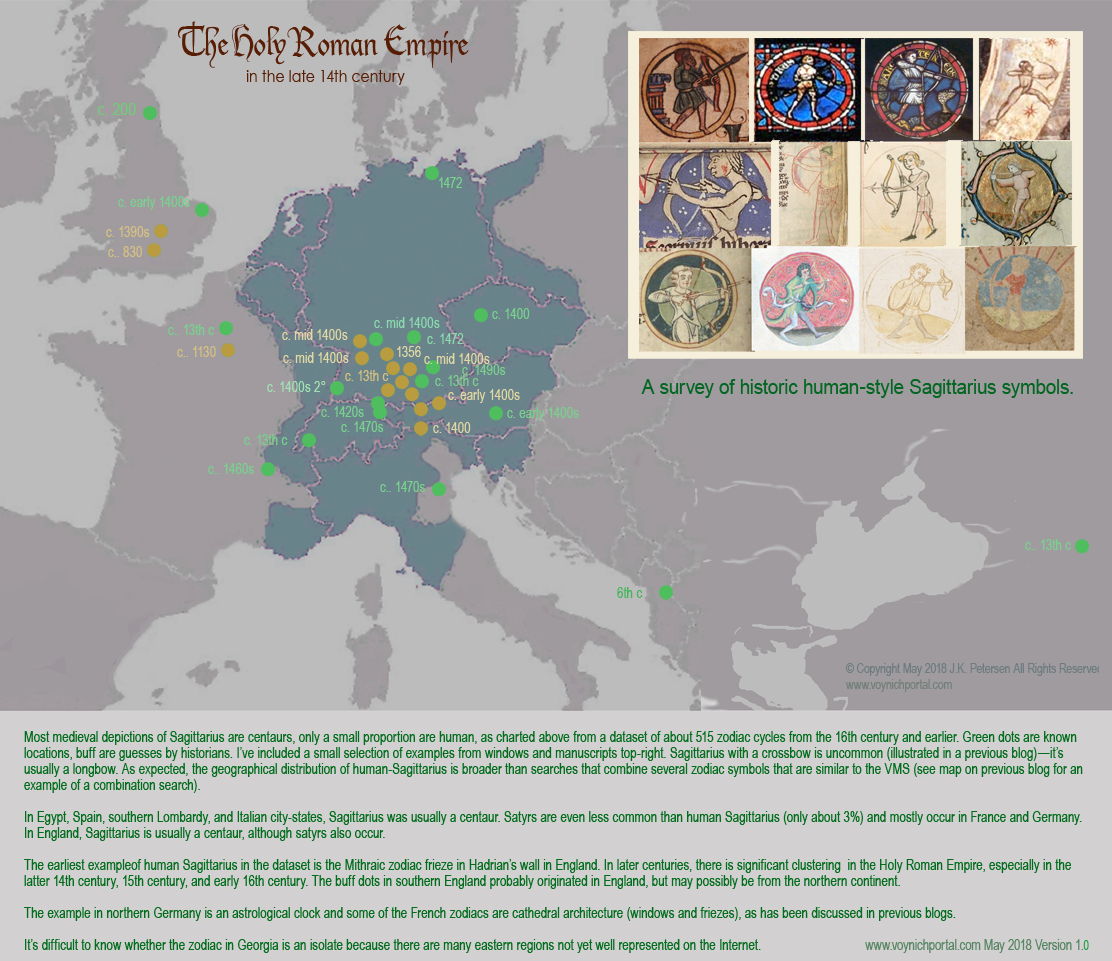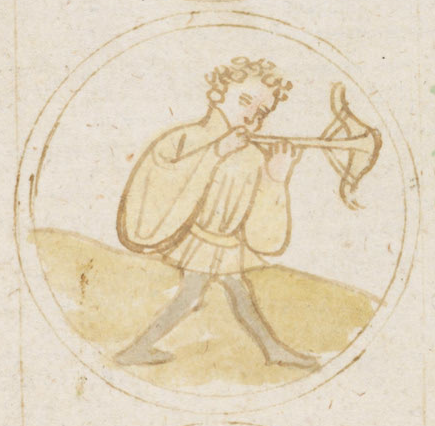Two days ago, I posted maps illustrating combination searches of medieval zodiac images similar to those in the Voynich Manuscript. Today, a simpler search explores Sagittarius as a two-legged human, distinct from centaurs and satyrs. This is different from previous Sagittarius blogs where I focused on the crossbow and tunic.
Background
Medieval images of Sagittarius generally fall into three categories: centaurs, satyrs, and humans. Most of them are holding longbows, a few have crossbows. Here are examples that illustrate common themes:
Note how the VMS fits naturally with the human-in-tunic style that became popular in certain regions, especially in the 14th to mid-16th centuries. Sagittarius as a satyr is primarily found in Germany or northeastern France.
Evolution
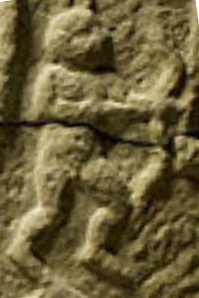 The Egyptians and Greeks represented Sagittarius as a centaur. The tradition of using a human was uncommon but can be seen in the sacred reliefs of Romans who followed the Mithraic religion in the second century. Not all the Mithraic Sagittarius carvings are human, the London relief shows Sagittarius as a centaur, but the one associated with Hadrian’s wall at Housesteads, England, is a nude archer with a longbow (right).
The Egyptians and Greeks represented Sagittarius as a centaur. The tradition of using a human was uncommon but can be seen in the sacred reliefs of Romans who followed the Mithraic religion in the second century. Not all the Mithraic Sagittarius carvings are human, the London relief shows Sagittarius as a centaur, but the one associated with Hadrian’s wall at Housesteads, England, is a nude archer with a longbow (right).
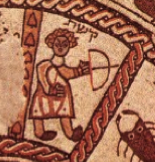 A few centuries after the fall of Rome, clothed human archers appear in Hebrew mosaics south of the Sea of Galilee, in the general area now known as Beit Alfa. This is not far from the birthplace of astrology as we know it, originating with the Chaldeans and Egyptians.
A few centuries after the fall of Rome, clothed human archers appear in Hebrew mosaics south of the Sea of Galilee, in the general area now known as Beit Alfa. This is not far from the birthplace of astrology as we know it, originating with the Chaldeans and Egyptians.
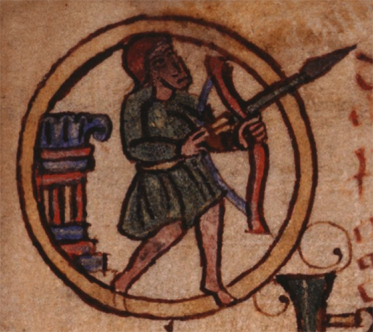 Back in northern Europe, probably England, Sagittarius-as-human didn’t vanish after the fall of the Roman Empire. It shows up in the early 9th century in Cotton MS Galba A XVIII, in a series that includes a double-headed crayfish and a bull with his tail between his legs. There are additional echoes of the VMS in the bumpy terrains under the feet, and suggestions of foliage in the background, but Virgo and Libra do not look anything like the VMS, and Scorpio is a double-headed serpent in the arms of a human (possibly a reference to St. George battling a dragon or perhaps Ophiuchus, the serpent-wrestling constellation). Leo doesn’t have a leg-tail or a protruding tongue either.
Back in northern Europe, probably England, Sagittarius-as-human didn’t vanish after the fall of the Roman Empire. It shows up in the early 9th century in Cotton MS Galba A XVIII, in a series that includes a double-headed crayfish and a bull with his tail between his legs. There are additional echoes of the VMS in the bumpy terrains under the feet, and suggestions of foliage in the background, but Virgo and Libra do not look anything like the VMS, and Scorpio is a double-headed serpent in the arms of a human (possibly a reference to St. George battling a dragon or perhaps Ophiuchus, the serpent-wrestling constellation). Leo doesn’t have a leg-tail or a protruding tongue either.
Continental Examples
In the 12th and 13th centuries, a number of Sagittarius-as-human figures appear in churches and manuscripts in at least three places: the northeast of what is now France, in the Holy Roman Empire (mainly Germany), and in a Christian cathedral in Georgia (Georgia has been primarily Christian since the 4th century).
There is also a brevarium from Seckau, Austria (Graz MS 286) with some VMS-like characteristics such as a simple scale, a crayfish, and nibbling animals, but I am very suspicious that the zodiac symbols may have been added in the 14th or 15th century, mainly because of the style and themes, and partly because of the way the drawings overlap the original text.
By the mid-1300s, some of the zodiacs with Sagittarius-as-human were starting to look like the Voynich bowman. In particular, a manuscript thought to be from Germany, held in the Regensburger library (Clm 13076), has several commonalities, including a lion with a protruding tongue, a mammalian or lizardy scorpio, human Sagittarius, and Cancer as a crayfish. There is also a vague suggestion of bumpy terrain:
About 40 years later, a zodiac with a leg-tail lion and human archer appears in the north (Trinity B-11-7, possibly England), but it features Cancer as a crab and Scorpius as scorpion, and only superficially resembles the VMS. Big cats with their tails between their legs (a position that cats prefer to avoid that became a popular visual emblem) weren’t specific to zodiacs, they were frequently used on banners, friezes, and coats-of-arms throughout Europe and parts of the Middle East.
By c. 1390 to c. 1405, examples of human Sagittarius can be found in Bohemia, and they have a number of commonalities with the VMS, including Leo with leg-tail, a crayfish, and Libra scales without a full figure. So, even though early lizard-style Scorpius emerged in northern France, if you look at several zodiac symbols together, those that are most similar to the VMS in the mid-to-late 14th century appear to be from the southeastern HRE.
Thus, if you ignore the crossbow for a moment, you will notice significant clustering of human-Sagittarius themes in the Holy Roman Empire:
A Tradition-Transmission Mystery
There is a zodiac cycle a little to the west of what appears to be a cluster in the SE HRE, an early-15th century manuscript from the Lake Constance area (not from St. Gall), one with similar themes to the VMS: a squatting Virgo, a crossbow, and Sagittarius wearing a tunic of the same style as the VMS (Cod. Sang. 827 c. 1425).
So, the question is, might the VMS illustrator have seen one or more of the south-eastern HRE manuscripts and/or one from the Alsace or possibly even the one from Seckau? Or did the Sang. 827 illustrator independently see manuscripts from the southeastern HRE and interpret them in a similar way, with no connection to the VMS?
That’s one way of looking at it, but another possibility is that there might be an intermediary manuscript created sometime between 1400 and c. 1425 that influenced both of them, possibly one that has been lost?
And, there’s a further possibility. When combination searches are used, the VMS has many commonalities with manuscripts from the mid-15th century.
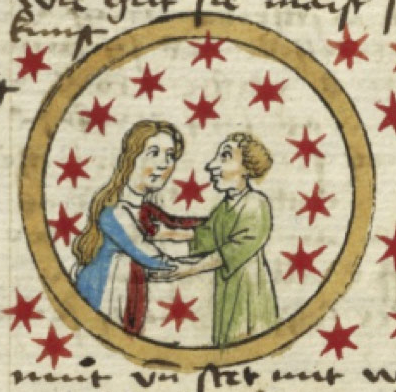 LJS 449 includes a crayfish, a leg-tail Leo, a human archer, and squatting Virgo gowned with many folds. Cod. Pal. Germ. 298, CGM 312, CGM 7269, 3085 Han, Estense De Sphaera, Codex Schürstab, and Sang. 760 (and several others) are similar, as well. Some that include combination themes also have romantic Gemini (e.g. Ludwig XII 8). Were the raw materials for the Voynich Manuscript stored for a decade or two before being used so that the contents belong to a later time period than the radio-carbon dated parchment? Might it have a closer kinship to southern German manuscripts from c. 1440 to 1470 rather than earlier sources from England or Burgundy/France?
LJS 449 includes a crayfish, a leg-tail Leo, a human archer, and squatting Virgo gowned with many folds. Cod. Pal. Germ. 298, CGM 312, CGM 7269, 3085 Han, Estense De Sphaera, Codex Schürstab, and Sang. 760 (and several others) are similar, as well. Some that include combination themes also have romantic Gemini (e.g. Ludwig XII 8). Were the raw materials for the Voynich Manuscript stored for a decade or two before being used so that the contents belong to a later time period than the radio-carbon dated parchment? Might it have a closer kinship to southern German manuscripts from c. 1440 to 1470 rather than earlier sources from England or Burgundy/France?
I’m hoping a series of combination searches will provide a better sense of which illustrative traditions may have directly influenced the VMS and which are incidental or coincidental.
Summary
This search is speculative, as it describes results from a very specific point of view—Sagittarius as human—and one has to be careful not to read too much into it because zodiac cycles can be extremely similar and still differ on a symbol or two but, once again I found it intriguing that the examples from this specific search clustered so dramatically in certain regions and time periods.
J.K. Petersen
© 2018 J.K. Petersen All Rights Reserved

